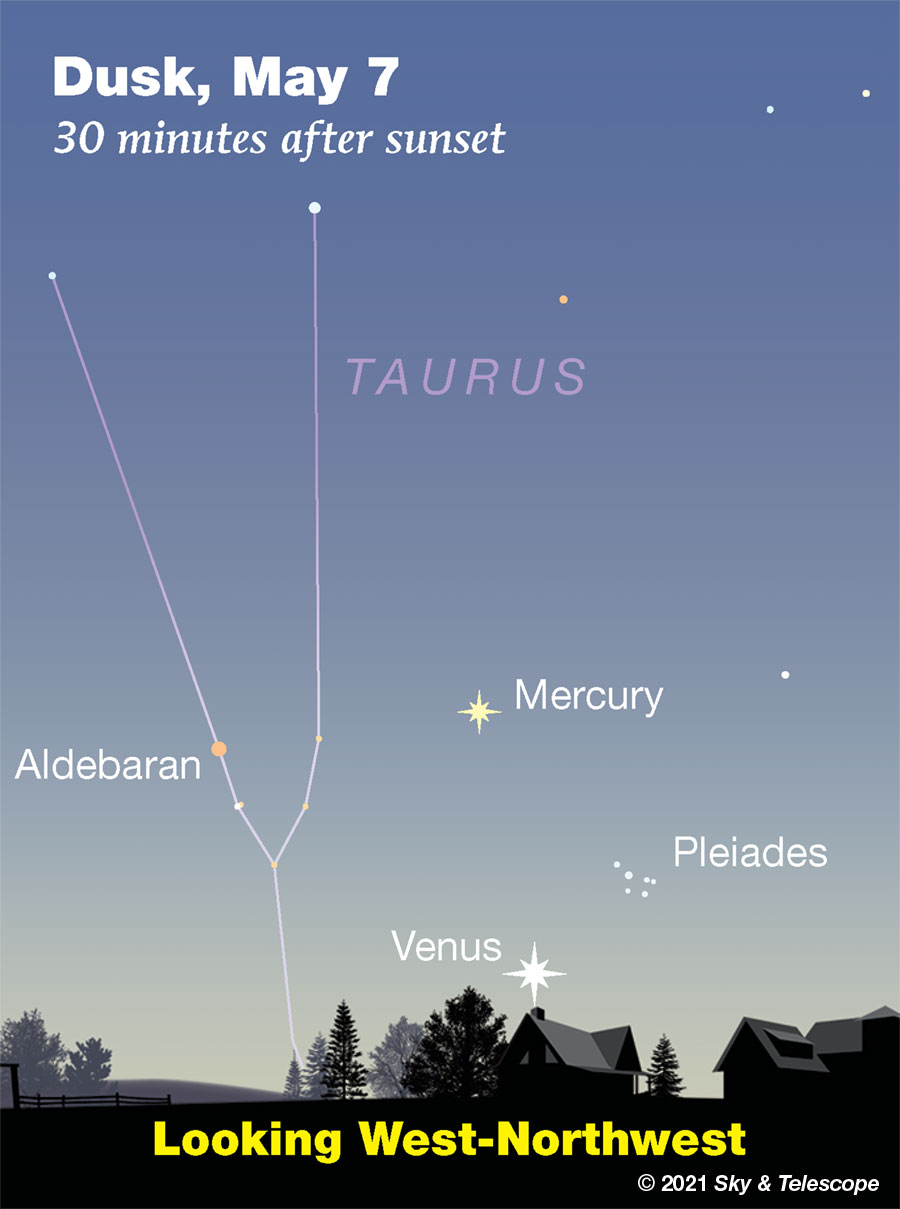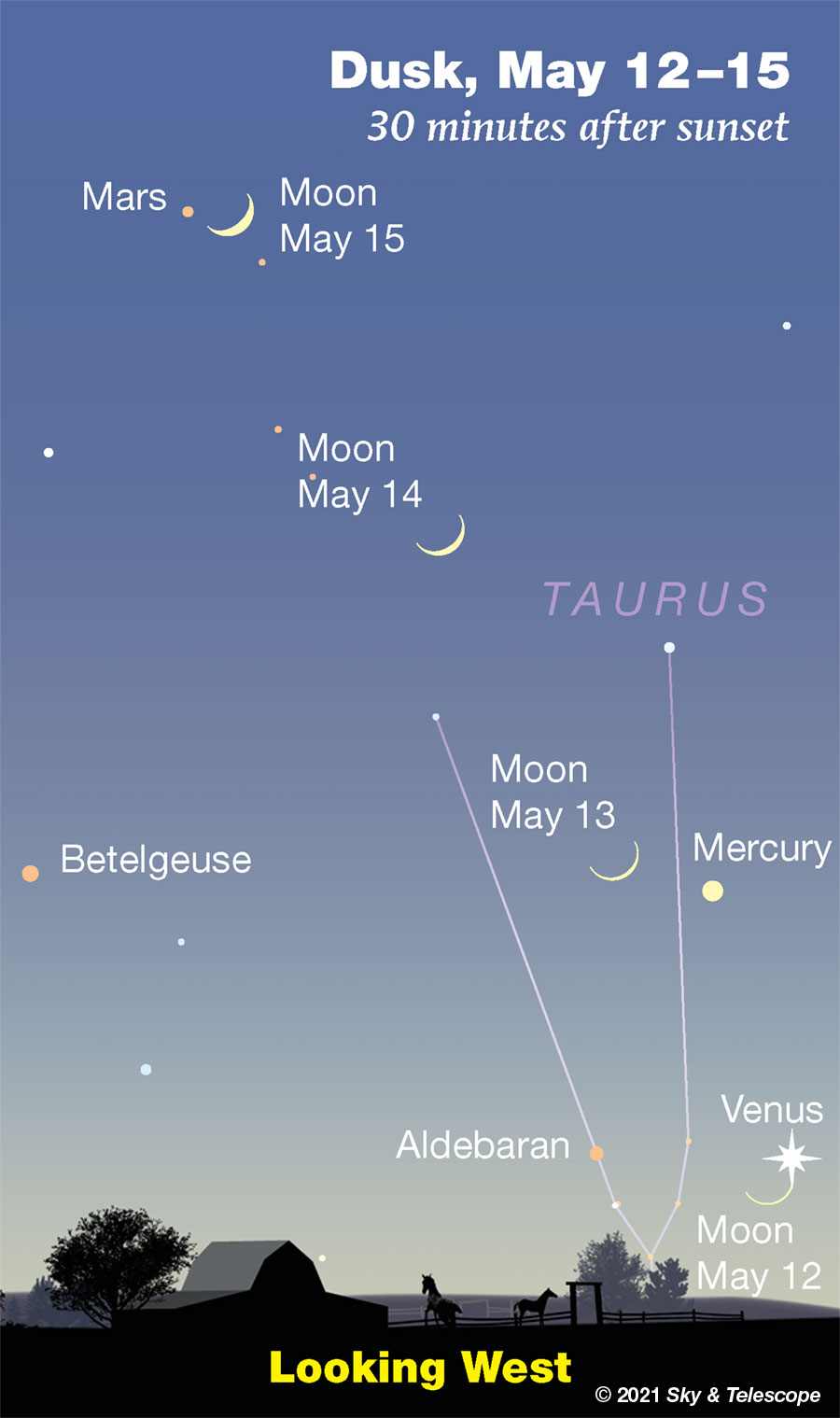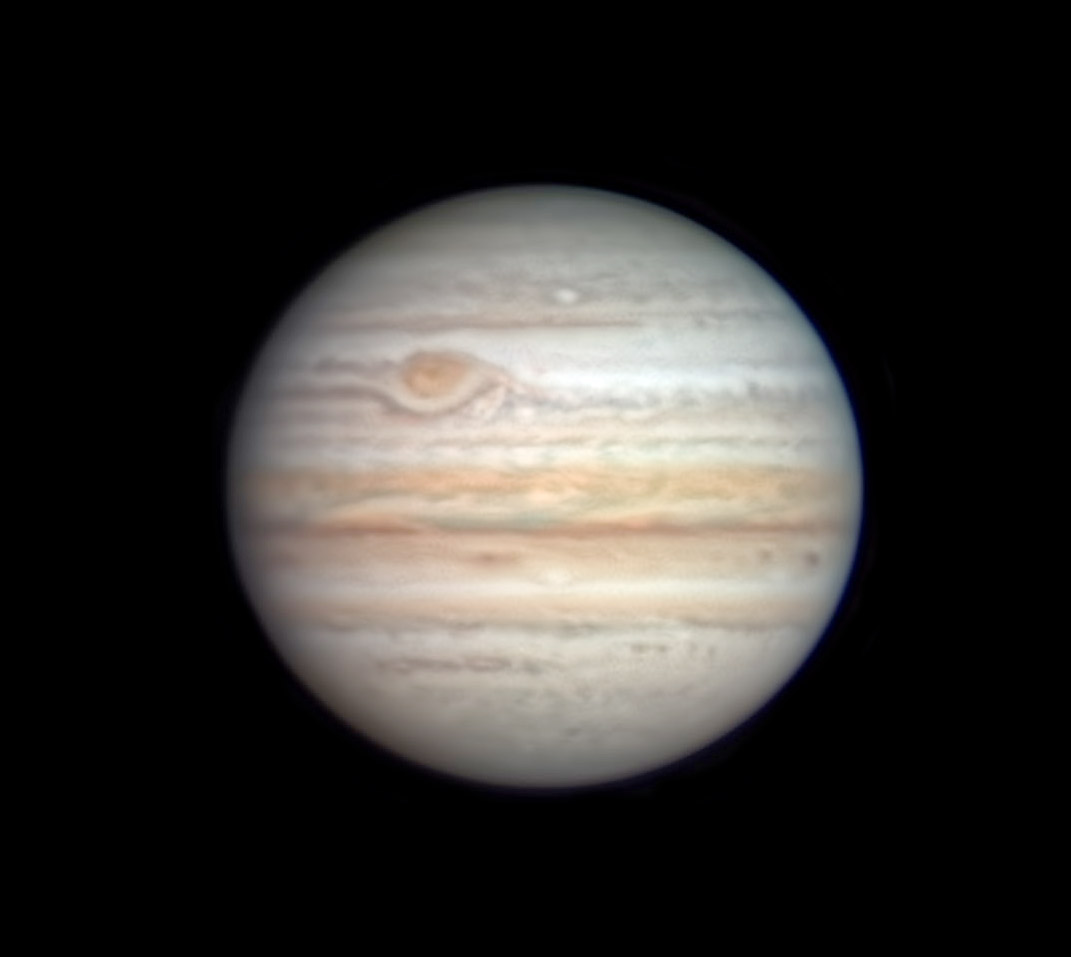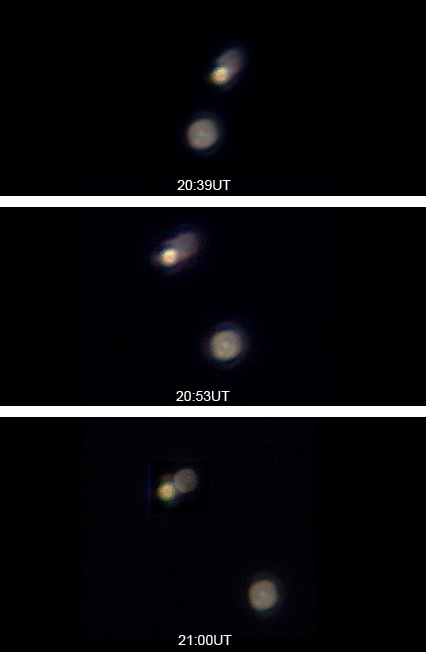UPDATE: Nova Cassiopeiae 2021 unexpectedly shot up to magnitude 5.4 around May 8th — faint naked-eye visibility in a dark sky — eight weeks after its initial outburst to 7th magnitude. It had remained at 7th or 8th during the interim. As of May 13th it had faded a little to magnitude 5.7. See Nova in Cassiopeia Brightens Suddenly, with finder charts and comparison stars.
The nova is low in the north in the evening but high in the northeast before the first beginnings of dawn. Set your alarm to look at least two hours before your local sunrise time.
Comet ATLAS (C/2020 R4) continued at 9th magnitude as of April 30th but should start fading rapidly. It's crossing Coma Berenices, conveniently high in the moonless evening sky. You may need at least a 6-inch scope. See Make the Most of Comet ATLAS.
FRIDAY, MAY 7
■ Greet Mercury and Venus low in the west-northwest in the fading afterglow of sunset. You may first spot Venus, bright at magnitude –3.9, very low exactly west-northwest. As the sky darkens further, Mercury will come into view some 9° above Venus as shown below. Mercury fades from magnitude 0.0 to +0.5 this week.

■ Much higher to their upper left, in the west as night falls, is little Mars. It lies on the base of the Arch of Spring: the base is the long line from Procyon on the left to Capella on the right. Mars will stand exactly on this line Tuesday May 11th. You can watch its daily progress toward and across this line by holding a yardstick or other straightedge to the sky from Procyon to Capella, or by stretching a string tightly from one star to the other between your hands.
Beware of the tricky illusion that a line on the sky parallel to the horizon is a straight line. Nope! The horizon itself is a great circle around the celestial sphere, so it's straight as seen by a viewer at the center of the sphere, meaning you. But a circle drawn around the sky at some constant altitude above the horizon will be a small circle, not centered on you, so any segment of it will be bent upward toward the ends. This effect becomes substantial high above the horizon and/or when you're looking across a large span of sky.
Many people cannot believe this is true. That's why to bring the yardstick or piece of string, rather than trying to judge a straight line from Procyon to Capella by eye — with the horizon sneakily enticing you to make it your reference line. Prove this to yourself!
SATURDAY, MAY 8
■ Summer is still six weeks away, but the Summer Triangle is making its appearance in the east, one star after another.
The first in view is bright Vega. It's low in the northeast as twilight fades.
Next up is Deneb, lower left of Vega by a little more than two fists at arm's length.
The third corner of the triangle is Altair. It shows up far to the lower right of Vega and Altair around 11 or midnight.
SUNDAY, MAY 9
■ Arcturus is the brightest star very high in the east. Spica shines lower right of it by about three fists at arm's length. Look to the right of Spica by half that distance for the distinctive four-star constellation of Corvus, the springtime Crow.
MONDAY, MAY 10
■ A gigantic asterism you may not know about is the Diamond of Virgo, some 50° tall and extending over five constellations. It now stands upright in the southeast to south after the stars come out. Begin with Spica, its bottom. Upper left from Spica is bright Arcturus. Almost as far upper right from Arcturus is fainter Cor Caroli, 3rd magnitude. The same distance lower right from there is Denebola, the 2nd-magnitude tailtip of Leo. And then back to Spica.
The bottom three of these stars, the brightest, form a nearly perfect equilateral triangle. So maybe we should call Arcturus, Spica and Denebola the "Spring Triangle" to parallel those of summer and winter?
In you have a dark sky, or binoculars, look halfway from Cor Caroli to Denebola for the very large, sparse Coma Berenices star cluster. It spans some 4°, about the size of a ping-pong ball held at arm's length.
TUESDAY, MAY 11
■ These spring evenings, the long, dim sea serpent Hydra snakes almost level far across the southern sky.
Find his head, a rather dim asterism about the width of your thumb at arm's length, in the west-southwest. It's lower right of Regulus by about two fists at arm's length. (Also, a line from Castor through Pollux points to it about 2½ fists from them.)
Less than two fists left of the head is Hydra's brightest star, 2nd-magnitude Alphard, his orange heart. Hydra's tail stretches all the way to Libra rising in the southeast. Hydra's star pattern, from forehead to tail-tip, is 95° long, longer than any other constellation.
■ New Moon (exact at 3:00 p.m. EDT).
WEDNESDAY, MAY 12
■ Venus and a super-thin crescent Moon pair up very low in the west-northwest in early twilight. Bring binoculars; the Moon is only 1% illuminated, just a few hours more than one day old (the Moon was new at 3:00 p.m. yesterday Eastern Daylight Time). The circumstances of this pairing will depend on where you are, but for much of North America they will be less than 1° apart. Mercury looks on from above.
Will this be your record-youngest young-Moon sighting?

The Moon is these scenes is, as always, drawn about three times its actual apparent size. Positions are exact for an observer at latitude 40° N, longitude 90° W, near the population center of North America. And remember, the visibility of faint little objects in bright twilight is exaggerated.
THURSDAY, MAY 13
■ This evening the crescent Moon, less thin and less low in twilight, bestows its company on Mercury after partnering with Venus yesterday. See above. And with those binoculars, can you pull out Betelgeuse some 20° to their left?
■ After full dark, the fine galaxies M81 and M82 are among the most-sought telescopic targets when the bowl of the Big Dipper is high. But have you ever tried for the two lesser galaxies in their vicinity, and the four double stars here for amateur scopes? Two of those are easy to resolve; two are challenging. See Ken Hewitt-White's Suburban Stargazer column in the May Sky & Telescope, page 54.
FRIDAY, MAY 14
■ In early twilight, spot the crescent Moon in the west-northwest as shown above. Upper left of it by about 13° (for North America) is little Mars. About the same distance lower right of the Moon is Mercury, and farther to the Moon's lower left is Betelgeuse, the last bright star of Orion to depart as spring advances.
SATURDAY, MAY 15
■ And now the crescent Moon shines with faint, far-distant Mars, which is nearly on the opposite side of its orbit from us. Mars is currently 18 light-minutes away, compared to the Moon's 1.3 light-seconds.
■ Three zero-magnitude stars shine after dark in May: Arcturus high in the southeast, Vega much lower in the northeast, and Capella in the northwest. They appear so bright because each is at least 60 times as luminous as the Sun, and because they're all relatively nearby: 37, 25, and 42 light-years from us, respectively.
This Week's Planet Roundup
Mercury and Venus come into view low in the west-northwest in the afterglow of sunset. You may first spot Venus, bright at magnitude –3.9, very low. As the sky darkens, Mercury will come into view some 9° above Venus. Mercury fades from magnitude 0.0 to +0.5 this week.
Mars (magnitude +1.7, in lower Gemini) glows in the west right after dark. It's not quite midway along the line from Procyon far to its left to Capella far to its right. In a telescope Mars is a mere 4.5 arcseconds wide: just a tiny, shimmering blob.
Jupiter and Saturn (in dim Aquarius and Capricornus, respectively) are well up in the southeast as the first light of dawn begins. Jupiter grabs the eye at magnitude –2.3. Saturn, 16° to Jupiter's right, is one sixteenth as bright at magnitude +0.7.


We're in a season of such mutual eclipses of Jupiter's moons; see predictions for this month in the May Sky & Telescope, page 50. Will you be lucky enough to have one occur while Jupiter is in its pre-dawn view from your location? Don't expect your scope to resolve Jupiter's moons into disks like this visually!
Uranus is hidden in the glow of dawn.
Neptune has barely risen by the time dawn begins.
All descriptions that relate to your horizon — including the words up, down, right, and left — are written for the world's mid-northern latitudes. Descriptions that also depend on longitude (mainly Moon positions) are for North America.
Eastern Daylight Time, EDT, is Universal Time minus 4 hours. Universal Time is also known as UT, UTC, GMT, or Z time. To become more expert about time systems than 99% of the people you'll ever meet, see our compact article Time and the Amateur Astronomer.
Want to become a better astronomer? Learn your way around the constellations. They're the key to locating everything fainter and deeper to hunt with binoculars or a telescope.
This is an outdoor nature hobby. For an easy-to-use constellation guide covering the whole evening sky, use the big monthly map in the center of each issue of Sky & Telescope, the essential magazine of astronomy.
Once you get a telescope, to put it to good use you'll need a detailed, large-scale sky atlas (set of charts). The basic standard is the Pocket Sky Atlas (in either the original or Jumbo Edition), which shows stars to magnitude 7.6.

Next up is the larger and deeper Sky Atlas 2000.0, plotting stars to magnitude 8.5; nearly three times as many. The next up, once you know your way around, are the even larger Interstellarum atlas (stars to magnitude 9.5) or Uranometria 2000.0 (stars to magnitude 9.75). And be sure to read how to use sky charts with a telescope.
You'll also want a good deep-sky guidebook, such as Sky Atlas 2000.0 Companion by Strong and Sinnott, or the bigger (and illustrated) Night Sky Observer's Guide by Kepple and Sanner.
Can a computerized telescope replace charts? Not for beginners, I don't think, and not on mounts and tripods that are less than top-quality mechanically, meaning heavy and expensive. And as Terence Dickinson and Alan Dyer say in their Backyard Astronomer's Guide, "A full appreciation of the universe cannot come without developing the skills to find things in the sky and understanding how the sky works. This knowledge comes only by spending time under the stars with star maps in hand."
![]() Audio sky tour. Out under the evening sky with your
Audio sky tour. Out under the evening sky with your
earbuds in place, listen to Kelly Beatty's monthly
podcast tour of the heavens above. It's free.
"The dangers of not thinking clearly are much greater now than ever before. It's not that there's something new in our way of thinking, it's that credulous and confused thinking can be much more lethal in ways it was never before."
— Carl Sagan, 1996
"Facts are stubborn things."
— John Adams, 1770
 1
1









Comments
ErnieOstuno
May 13, 2021 at 6:13 pm
Yes! We had really clear and dry air in Michigan last evening, May 12th and I was able to see the thin crescent moon next to Venus. The youngest moon I've seen yet and Venus made it easier to find.
You must be logged in to post a comment.
You must be logged in to post a comment.